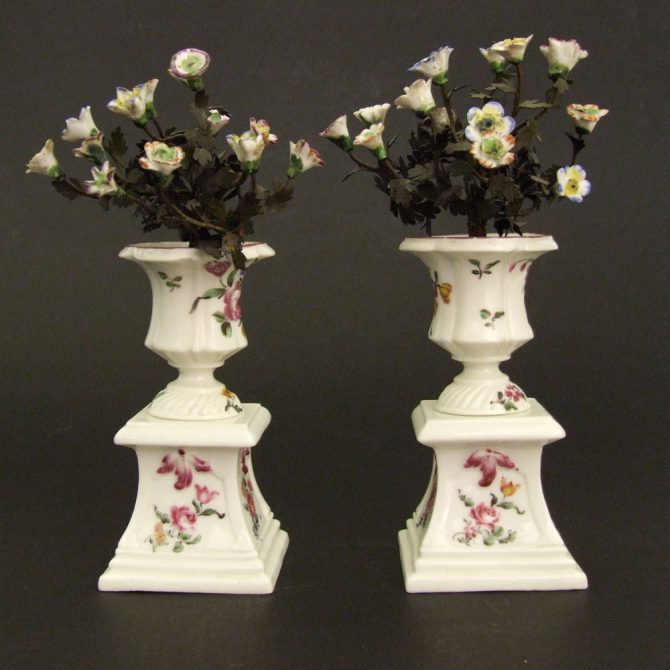
MENNECY c.1750 – 1755 French Soft Paste Porcelain
A Pair of 18th Century Mennecy Soft-Paste Porcelain Jardinières of Medici Form with Pedestal Stand with Painted Metal Plants and Painted Porcelain Flowers. The Metal Later.
These miniature vase is based on the well known Medici vase and appears unique to the Mennecy factory. pedestal stands were made by many porcelain factories in continental Europe during the 18th century. It is rare to find metal plants with porcelain flowers in situ.
SOLD
- Condition
- No damage but the metal later.
- Size
- Height (Including flowers) : 16.5 cm (6 1/2 inches).
- Provenance
- The Darblay Family Collection of 18th Century Mennecy Porcelain. This important collection of Mennecy porcelain was formed in the 19th century by the Darblay family, especially the paper magnate Ayme-Henri Darblay (1854-1899). The family lived near Mennecy and built up an extensive collection of porcelain from the factory. Ayme-Henri published `Villeroy, Son Passe, Sa Fabrique de Porcelaine et Son Etat Actuel` in 1901. This sumptuous book is still an important reference guide to Mennecy porcelain.
- Stock number
- 22254
- References
- For two similar pieces without flowers see : French Porcelain, A Catalogue of the British Museum Collection (Aileen Dawson, British Museum Press 1994. ISBN 0-7141-0545-7) Page 56 and 57 Item 58. Also see `Sold Items` stock number 19712 for a Mennecy Jardinières and stand with metal palnts with porcelain flowers.
Information
Mennecy Porcelain :
The factory was started by Francois Barbin under the protection of Louis-François-Anne de Neufville, Duc de Villeroy (1695-1766). Barbin had been making faïence under Villeroy`s protection, he was also making porcelain in Paris from 1734/35. He had to move to the grounds of the Château de Villeroy, near the village of Mennecy (Île-de-France) in 1748 because Francois Barbin did not have letters of patent from the king and so was refused permission to produce porcelain in Paris. A monopoly was enforced with legal action taken to prevent anyone producing porcelain "in the manner of Saxony" (i.e. Meissen porcelain), this monopoly was granted to the manufacture of porcelain at Vincennes. Legal action was used to close down the Paris factory, this included impounding the porcelain and then reselling it. The earliest porcelain produced at Mennecy (1734-1748) is so far unidentified. The porcelain made after 1748 tends to be rather light and the glaze often has a pearl like appearance. Most of the production consists of small pieces of porcelain for the table and dressing sets, small boxes and small porcelain figures were made too. The pieces are often but not always marked with an incised `D V` to the base for the Duc de Villeroy. Mennecy porcelain was copied/faked by the 19th / 20th Paris firm of Sampson, these pieces also often carry the incised `D V` mark.






